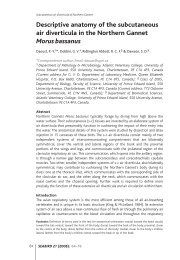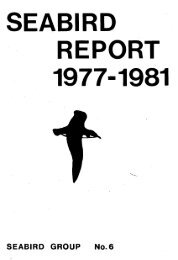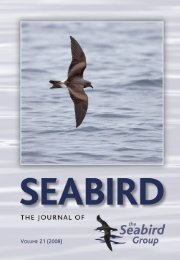Create successful ePaper yourself
Turn your PDF publications into a flip-book with our unique Google optimized e-Paper software.
154 B. CADIOU Atlantic <strong>Seabird</strong>s 3(4)<br />
by plumage features, they were potentially at least 50 days old on the date when<br />
the empty nest was recorded.<br />
RESULTS<br />
Laying period In 1995, the few available data, for 9 chicks at one colony only,<br />
indicated a similar temporal pattern of laying to that in 1975. In 1996, more data<br />
were collected and the results indicated a delay in the laying period. Laying<br />
ranged from the end of May to the end of July, with 50% of laying around mid<br />
June (Fig. 1). This pattern of laying is closer to that recorded on Skokholm,<br />
Wales. In 1997, laying was more advanced than in the previous year and ranged<br />
from mid May to the end of July, with 50% of laying around early June. In<br />
1998, a long delay in breeding was recorded. As in 1996, laying ranged from the<br />
end of May to the end of July, but 50% of laying was around early July (Fig. 1),<br />
i.e. 6 weeks later than in 1975. It appeared that a problem for the birds occurred<br />
in early June, with a temporary break in laying from 5 to 17 June. In 1999, the<br />
pattern of egg laying was very similar to that in 1997. Laying ranged from early<br />
May to mid July, with 50% of laying around early June. Field observations<br />
suggested that some eggs were probably laid during the first ten days of August,<br />
and perhaps even later. For example, on Banneg Island, one bird was found<br />
incubating an egg on 20 August 1999 and his partner on 9 September. Two<br />
weeks later, the egg was abandoned. Furthermore, from 1996 to 1999, the<br />
pattern of egg laying in Brittany appeared to be very similar between northern,<br />
western and southern colonies.<br />
Attendance patterns A simple attendance model, assuming continuous<br />
attendance of one parent during the 41 days of the incubation period and the 7<br />
first days of the chick’s life (Ratcliffe et al. 1996), allows investigation of a<br />
potential effect of interannual variation in laying patterns on census results (Fig.<br />
3). <strong>The</strong> results indicate that observers could sometimes easily underestimate a<br />
large change in breeding numbers using tape-playback methods in early July for<br />
example (Fig. 3). Depending on the year and the laying phenology, the<br />
theoretical proportion of nests attended can vary between about 90-95% and 60-<br />
65% or even less if the census is made a few days earlier or later in years with<br />
late or early breeding respectively (Fig. 3).<br />
Breeding parameters A sample of 49 eggs was measured in 1999 in the<br />
Molène archipelago colonies. <strong>The</strong> mean size was 27.9 × 20.6 mm (± SE: 0.2 ×<br />
0.1; range: 25.6-30.1 × 18.3-22.3 mm).<br />
Data obtained from Enez Kreiz islet showed that hatching success<br />
ranged from 63.6% to 95.7% (Table 1); the uncertainty was due to some sites








